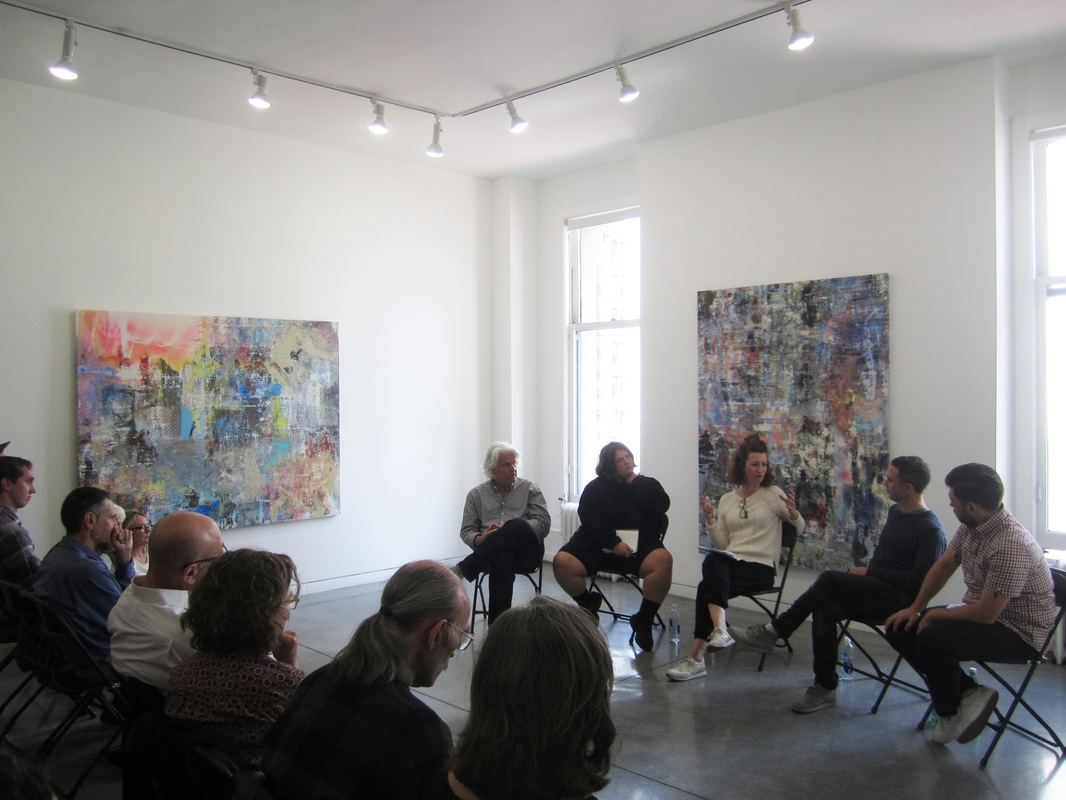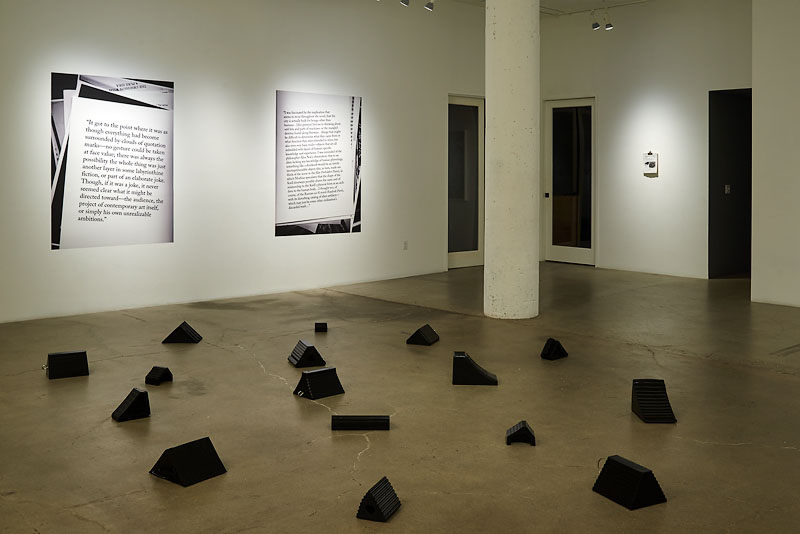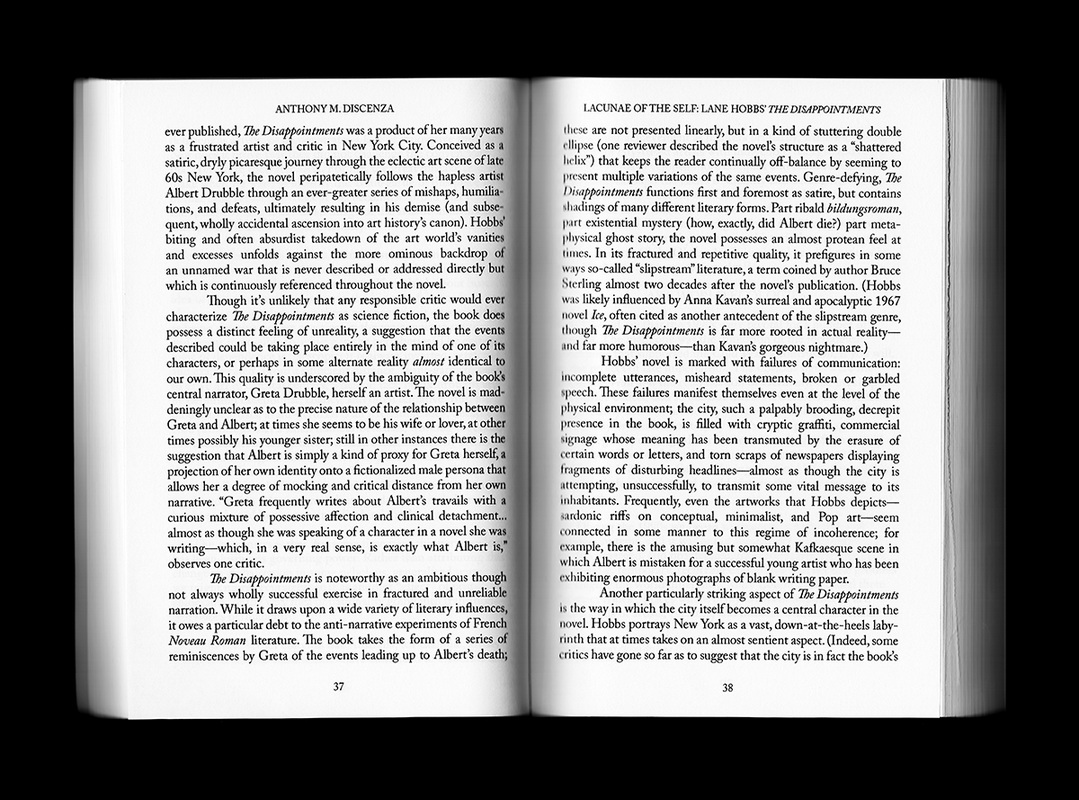|
On Saturday April 23rd, Glossary attended a panel discussion that happened at Altman Siegel Gallery in San Francisco.
The topic was “Painting: For and Against,” moderated by Leigh Markopolous, Chair of Curatorial Practice at California College of the Arts. Panelists included:
Glossary’s Editor in Chief, Leora Lutz took feverish notes at the discussion. The acoustics were terrible at times, as the bustle from busy Geary Street in downtown SF bellowed up into the 4th floor windows. Therefore, in the spirit of Abstraction, the notes here are abridged and sometimes paraphrased to reflect the at-times abstraction of the conversation and the setting.
Panel discussions are not something normally covered by the press, so Glossary fills this need with its series Review as Dialogue. The series is not a transcription or a podcast, but rather notes in real time, with real human mistakes, just like memories. There are no direct quotes unless noted in quotation marks. Notes were taken in-situ, and are not literal transcriptions of neither audio nor direct quotes (unless otherwise noted), but rather points that were touched upon. Certain key word choices and diction has been retained to accurately reflect the tone and sentiment of the discussion [+notes for reflection and/or clarity]. Enjoy.
LEIGH MARKOPOLOUS
. . . conversation around painting . . . textured range of perspectives . . . Why? . . . painting and post WW2 gave way to Abstract Expressionism/Minimalism in response to Ab Ex . . . materiality . . . market appeal . . . “Zombie Formalism” . . . essentialism . . . fetishizing processs . . . *Village Voice article by Jerry Saltz, “Zombies on the Wall: Why Does So Much New Abstraction Look the Same?” . . . art arises by talents, subject to a division of . . . the departure . . . “crapstraction” . . . provisionalism. [*The article appeared in Vulture, which originally appeared in the New York Magazine, June 16, 2014 issue]. Peter Schjeldahl article “Take Your Time; New painting at the Museum of Modern Art,” in The New Yorker, regarding the exhibition “The Forever Now: Contemporary Painting in an Atemporal World,” featuring 17 artists. [It’s not that painting is “dead” again—no other medium can as yet so directly combine vision and touch to express what it’s like to have a particular mind, with its singular troubles and glories, in a particular body. But painting has lost symbolic force and function in a culture of promiscuous knowledge and glutting information.] . . . nobody thought to bother with it . . . Vision and touch, promiscuous . . . strike a chord with insecurity? LIAM EVERETT I have a repetitive practice. There is an energy that comes from it. Again and again —indicative of being human. There’s power in it. It’s not like I look at a painting and think, “I have never seen this before,” and I am not necessarily looking for that. Exciting . . . Something unfamiliar resonates out of the familiar. Sometimes a “call” goes out with the work and I get an echo in response, sometimes this is daunting. I don’t want to blame the area (Bay Area) but here are isolated pockets of dialogue and it’s easy to drift away and become a satellite. LM Repetition . . .in everything you do. K.r.m. MOONEY Meditation a process. . . . speaks about how an object arrives. How it operates is outside of itself . . . formal elements emerge. Repetition—I think of the body as an entry point that you cannot escape. . . . closeness with the material, with what you are working with and a sensitivity to the material. JOHN ZURIER . . . Material . . .I have been painting since 1978, around the time that an article came out stating that Painting is Dead. [jokes: so I have great timing, audience laughs] I didn’t choose painting. I’m a painter, that’s how I think. Painting (P/) has a deep history. It’s a lot like God. [When we talk about God, we can say a lot and nothing at all, it means something a little different to everyone]. People try to get rid of P/, but it’s like air. [We cannot get rid of it, we cannot pin it down]. From caves to modernism, the history of P/ is deep.
LM
Writing about art [What have you been reading] . . . Andrew, in 2014 you published an article titled “Who’s Afraid of the New Abstraction,” . . .(?) ANDREW McCLINTOCK I began to enjoy abstraction more once I began to live with it in my own collection, as well as showing it in my gallery. Abstraction offers exchange of ideas around these topics. [ideas, the market, whether or not it is dead]. LE . . . grounded in the moment, an *Artforum article Jacqueline Humphries through the eyes of David Bowie *There is also an article in the Independentdiscussing Bowie’s video with the work of Jacqueline Humphries. KM I think of the book, *Thinking Through the Canvas, which contains personized activities, an index of agency, determining its limits, the entrances and exits of self-referentiality, of self-reflexivity. Thinking across disciplines. There is a long history of specialists who are concerned with the value of positionality in terms of subjecthood . . . adjacent background . . . practice formalism and can operate as agents. *Thinking through Painting: Reflexivity and Agency beyond the Canvas by Peter Geimer
LM
How do the ideas remain sustained after so many years? JZ Coffee. The same thing the whole time. . . How to make something real and non-verbal. I am an optimist. I don’t make a picture, I make a feeling. I communicate what I am experiencing. (P) and Painters are 2 different things. People say that (P) is affected by the market—but it is people who are affected by the market. (P) delivers to our nervous system. (P) resolves issues of structure. All (P) when it moves to the monochrome is saying that life and art are coming together.
LM
Is (P) enough? JZ (P) is not entertaining and fun. (P) is in the expanded field now. Things are considered (P) that others do not consider (P). (P) is difficult. It is a language . . . AM I am always jealous of painters in a way . . . that idea of the lone artist facing a blank canvas and “going to battle.” It’s a powerful symbol of what it means to be an artist. [at least that is the mystique]. LM (inaudible mumbling about violence) AM Well, I suppose some people use the terms “journey” or “adventure.” The idea of the unknown that you are faced with, it’s just you and the materials. LM A kind of heroism, romanticism, an almost Biblical idea of the Painter. LE There is a certain level of self-loathing involved. A physical element and isolation to sit and deal with the images, one-on-one with the images, and images that don’t move. [We are bombarded with moving images, the internet, television, movies—painting is a static image.] AM These move [gestures to Everett’s work] LE Do you ever ask yourself “why?” [to Zurier] JZ Never KM No, I don’t. Something is always arriving. You have to come to/from the space of the canvas. It’s not neutral. There is a history there, emerging from it.
JZ
The rectangle automatically conjures history. The critic sees it “all done” and comments on that . . . “Not for or Against” [the canvas]. LE It’s for AND against. Metaphor of repetition we can all access . . . signs on the surface. There are things that are flat surfaces, we all know what it is to make a mark—it is a lived experience. AM (P) does not have to be paint. Artists call what they are doing (P) or that they are doing paint, yet there is no paint there. JZ It’s a language. Not a verbal language, it’s a visual language. There are very few words for it. In French they use the word “tableau” [that is somewhat a better word because it means “little table” – things that are on it. In linguistics, tableau is a method of evaluating strengths of a set, or truths to various logic in relation to meaning]. The (P) leave the studio so they can live outside of it. Then we have to think of what the studio means. The tendency is when talking about (P), we talk about what is special to it.
Audience 1.
What is special about (P)? Audience 2. And drawing, what is special about (P) as opposed to drawing? AM Everything is conceptual now, Is (P) performative? LE I disagree [with everyone]. There is something special with (P). I tried to run from (P). I did performance, I did song. But every time I make a mark I know I am here. I make another mark and I know I am here, I make another mark—I am here. I have an index of proof that I am here. I go through a process of editing—What do I allow? What is important? Drawing and (P) are married. And also (P) is a performance. In a way it is the best kind of performance because there is no audience. There is movement, there is breath of the form there. AM Action LE Yes, this is where I disagree that (P) is conceptual. [If we view conceptual work as thought, and that the object does not “matter”] You cannot just think of painting for it to function. The idea cannot be divorced from the action.
Audience 3.
(P) is expensive, drawing is not—that’s what makes it more special. [audience laughs] The mark is always new. Is there an analogy in here with music? We don’t say things like “Sound is dead,” “Music is dead, “Tone is dead.” LM Is there a “point” in saying Something? LE Thank God (P) is always dying! Every time something goes another thing comes in. I thrive on constant dying and recycling. It’s “not special.” AM Both music and painting elicit emotional reactions. Audience 4. In response to “(P) is dead.” I’m old—older than jazz—Painters roll all night because we have to. It’s an addiction. We need to create, so yes the act of (P) is special. Why? I have to. Is that true with any creative function? LM In working with students I see it, they are compelled to do it. Not because they are too lame to do anything else, but because they cannot do anything else—it is there way of being. Claudia Altman Siegel What makes a good (P)? What makes a bad (P)? KM When (P) resonates, it is good. Audience 5. It gives it a new life in the gallery, the viewer adds to its impression, and so does that change it? LE It challenges that. There is a problem, and that is (P) goes out into the world. When we stop working on it, it is not finished. When it goes out it becomes something else. It has a Quality. How it is delivered is its completion. They are “open documents.” Experiences that are unresolved, formal, spiritual, asking and demanding questions. It is not in a formal language . . . I want to have a sensual experience. I want to be confronted with the thing, sharing this room. Who else is in the room? How are things living and involved together. The studio as an isolated place is a delusion. There are always implications there. 5. Are you aware that someone will see it? LE It is “caca” [sic] that we make work without anyone else. We are always together, engrained. We are not alone, there is some other person or voice with us, with me “making this thing.” JZ I need/want to feel nourished. To use the God analogy again, it is too big, it is deep and personal. The feeling of going into the studio is not a competitive place, it makes me want to DO something. The viewer completes the work. Until that happens, in between me and the (P) is when [it’s done it’s thing]. We are giving expression so people can have a connection. There is generosity there. Audience 6. I come from an architecture background. In architecture there is always an intentionality behind what we do—is that the case with painting, too? KM Desire to be a perpetual student . . . looking at science, philosophy, theory . . . does not bind or implicate the viewer as a participant in the work. When the intentions on position is thoughtful, it leaves a generous amount of room that contains many different kinds of reads, a multiplicity of how it operates. JZ feeling . . . thinking . . . I have definite intentions. But I am not consciously aware of them until after the work is made. I often end up defining something without looking for it. Finding out, seeking.
Did you enjoy this post? Consider making a small donation to support operating costs to transcribe more articles like this. Any amount is greatly appreciated!
Altman Siegel Gallery will soon be relocating to Dogpatch, near Minnesota Street Project. For now, they are still at their 49 Geary address for the next two exhibitions, featuring Jessica Dickerson April 28 – July 2, 2016, and Nate Boyce July 7 – September 2, 2016.
All images: Glossary Magazine. Paintings, Liam Everett.
3 Comments
Anthony Discenza Presents A Novel: an Exhibition by Anthony Discenza February 27–April 16, 2016 Catharine Clark Gallery 248 Utah Street San Francisco, CA 94103 Tuesday, Wednesday, Friday & Saturday: 11-6; Thursday: 11 -7 Glossary is elated to present our newest Review as Glossary for your pondering pleasure. We want to preface this entire entry with our slogan, “art reviews through a creative lens,” and we really mean it this time! Conceptually, everything about this show is very much a glossary: a set of indexes and terms isolated at the end of a book, or in this case—the aftermath of a process; our namesake review seemed most fitting. Enjoy! Glossary recently visited Anthony Discenza’s solo exhibition at Catharine Clark, which focuses on the life and times and unrealized works of Anthony Discenza, currently presented as an exhibition of an unrealized exhibition, based on a novel that was never written, called The Disappointments. The exhibition accompanies a stunning piece of ephemera: a black and white newsprint multi-page folded broadsheet of heady texts accompanied by moody and beautiful yet disturbingly advertisement-like photos that mirror “life-style” images from social media platforms or sites designed to offer guidance for souls bogged down by life’s tribulations to creatively succeed. A substantial essay titled Considering a Novel: An Exhibition in the Subjunctive is written by Anthony Discenza about Anthony Discenza. In it, the formation of the exhibition along with its shortcomings and ultimate solution are detailed in autobiographical prose. Speaking in the first person about Anthony Discenza, Anthony Discenza considers the work of the former while acknowledging the latter as author, artist and critic of his own making. Furthermore, the exhibition is an archive of gathered information, of which comprises elements never ultimately realized for an exhibition that was to take place in 2016, but has not and will not and is not. Art, not art, made into an exhibition that was not supposed to be, including things not considered art, and things so art that they hurt. glossary:EPHEMERA noun - something of no lasting significance —usually used in plural - ephemera plural : paper items (as posters, broadsides, and tickets) that were originally meant to be discarded after use but have since become collectibles - things that exist or are used or enjoyed for only a short time. - items of collectible memorabilia, typically written or printed ones, that were originally expected to have only short-term usefulness or popularity. NOVEL adjective - new and not resembling something formerly known or used - original or striking especially in conception or style noun - a fictitious prose narrative of considerable length and complexity, portraying characters and usually presenting a sequential organization of action and scenes. SUBJUNCTIVE grammar - of or relating to the verb form that is used to express suggestions, wishes, uncertainty, possibility, etc. - of, relating to, or constituting a verb form or set of verb forms that represents a denoted act or state not as fact but as contingent or possible or viewed emotionally (as with doubt or desire). THE SELF (Jungian psychology simplified) One of the Jungian archetypes, The Self is comprised of the unification of both the consciousness and unconsciousness in a person. Through a process of individuation, one’s personality becomes fully integrated between the two centers of one’s personality: the ego and the awareness of both the unconscious and the conscious as a single, interconnected way of being in the world. Individuation is the process by which a person’s experiences, elements of their personality, the psyche (perhaps forever immature) and the mature growth of decision-making all converge together to form a well-functioning whole. A person who has a sophisticated understanding of the self, is sometimes in colloquial terms considered “fully formed.” Full disclosure: Anthony Discenza was an adviser for Glossary's editor and writer while she was in grad school. She has written about his work previously. To fully understand Anthony Discenza’s exhibition about Anthony Discenza, visit the exhibition on view at Catharine Clark Gallery until April 16th, 2016.
There will be a closing reception on Wednesday, April 13th at 6pm. |
Reviews
All
shop
Eco-mindful journals by Glossary Syndicate
glossary's FOUNDER & author
thank you for visiting
Consider making a donation to support operating costs, research & writing time. Any amount helps!
reviews
All
other sf art publications
SFAQ
Art Practical Articiple SF Art Enthusiast SF Weekly SF Gate/Chronicle SF/Arts (Monthly) Stretcher Sartle global sf coverage
|













 RSS Feed
RSS Feed